Names in other languages: Pasta de soja (Spanish), Missô (Portugese)
You must have heard about “miso” only in Japanese movies and literature. It would have been mentioned a dozen times particularly because of its great taste and influence in Japanese and Chinese traditional food. In fact, the Japanese begin their day with a warm bowl of miso soup, which is believed to stimulate digestion and energize the body. Miso is a famous seasoning made by fermenting rice, barley, or soybeans, with salt and fungus kojikin. Miso has been a part of the Japanese culture for centuries. The taste, aroma, texture, and appearance of miso vary from region to region and also with season. Miso is used in various forms, the most popular being the miso soup which is a staple food in the Japanese cuisine. It is also used in many other soup-like dishes, such as ramen, udon, nabe, and imoni. Apart from serving great taste, miso offers loads of wonderful health benefits. Due to its increasing health promoting properties, miso is gaining popularity in the West. Give yourself know-how about the plethora of wholesome advantages that miso offers to your body and overall health.
History
The history of miso can be traced back to China. Its predecessor, “hisio” was a seasoning prepared from fermenting soybeans, wheat, alcohol, salt, and other ingredients. It is believed that miso was a luxury food item limited only to wealthy aristocrats. Around the 7th century, this soybean paste was introduced to Japan. Miso was initially made without grinding the soybeans until the Muromachi era. In the Kamakura era, a common meal made from rice, dried fish, miso, and fresh vegetables was quite famous. It was during the Muromachi era when Buddhist monks discovered that soybeans could be ground into a paste, thereby introducing new cooking methods for using miso to flavor other foods. The process of producing miso was relatively simple which led to the spread of homemade versions throughout Japan. During the Sengoku era, miso was used as military provisions and making miso became an important economic activity for daimyos of that era. In the Edo period, miso was also known as hishio and kuki, and various types of miso, based on climate and culture, were formed in Japan. These days, miso is gaining extreme popularity in the United States due to the intense recognition of macrobiotic diet and escalating interest in Asian food culture.
The history of miso can be traced back to China. Its predecessor, “hisio” was a seasoning prepared from fermenting soybeans, wheat, alcohol, salt, and other ingredients. It is believed that miso was a luxury food item limited only to wealthy aristocrats. Around the 7th century, this soybean paste was introduced to Japan. Miso was initially made without grinding the soybeans until the Muromachi era. In the Kamakura era, a common meal made from rice, dried fish, miso, and fresh vegetables was quite famous. It was during the Muromachi era when Buddhist monks discovered that soybeans could be ground into a paste, thereby introducing new cooking methods for using miso to flavor other foods. The process of producing miso was relatively simple which led to the spread of homemade versions throughout Japan. During the Sengoku era, miso was used as military provisions and making miso became an important economic activity for daimyos of that era. In the Edo period, miso was also known as hishio and kuki, and various types of miso, based on climate and culture, were formed in Japan. These days, miso is gaining extreme popularity in the United States due to the intense recognition of macrobiotic diet and escalating interest in Asian food culture.

http://blog.fatfreevegan.com/2007/10/double-mushroom-miso-soup-and-sesame.html
Health Benefits of Miso
- Studies reveal that miso contains dipilocolonic acid, an alkaloid that chelates heavy metals like radioactive strontium. As a result, miso is essential for discharging these heavy metals from the body.
- Miso, like other soyfoods, contains high concentration of a potent anti-cancer agent known as genistein. Researches indicate that miso contains 25 times more genistein than other unfermented soyfoods, like soy milk and tofu. As such, miso is beneficial in lowering the risk of cancer, especially breast cancer.
- Miso has high concentration of essential isoflavones, which are important in reducing cholesterol in the body. Hence, it effectively reduces the risk of coronary heart diseases.
- Being a good source of powerful antioxidants, miso sharply eliminates free radicals from tissues and protects cell membranes from ageing. In turn, miso is a good natural agent for resisting ageing.
- Studies show that miso soup has the ability of reducing chronic pain and facilitating calmness and tranquility.
- Miso is rich in several essential minerals, such as sodium, zinc, copper, and manganese, which are necessary for various vital functions of the body. Zinc acts as an important cofactor in a wide variety of enzymatic reactions which are significant for immune function and wound healing.
- Copper and manganese, found in miso, are important enzyme cofactors and essential components of the enzyme, superoxide dismutase, which is essential in energy production and antioxidant defenses. Copper is also responsible for providing ground substance and flexibility in blood vessels, bones, and joints. Copper helps in hemoglobin synthesis which is necessary for transporting and releasing oxygen throughout the body.
- Miso helps in secreting digestive fluids in the stomach, thereby facilitating and regulating digestion.
Miso Nutrition FactsAmount: 1 cup
Weight: 275 g
Weight: 275 g
| Nutrients | Amount |
| Basic Components | |
| Proteins | 32 g |
| Water | 118 g |
| Ash | 35.2 g |
| Calories | |
| Total Calories | 547 |
| Calories From Carbohydrates | 296 |
| Calories From Fats | 138 |
| Calories From Proteins | 112 |
| Carbohydrates | |
| Total Carbohydrates | 73 g |
| Dietary Fiber | 15 g |
| Sugar | 17 g |
| Fats & Fatty Acids | |
| Total Fat | 17 g |
| Saturated Fat | 3.1 g |
| Monounsaturated Fat | 3.4 g |
| Polyunsaturated Fat | 8.8 g |
| Omega-3 Fatty Acids | 1.2 g |
| Omega-6 Fatty Acids | 7.6 g |
| Vitamins | |
| Vitamin A | 239 IU |
| Vitamin E | 28 mcg |
| Vitamin K | 81 mcg |
| Thiamin | 270 mcg |
| Riboflavin | 641 mcg |
| Niacin | 2.5 mg |
| Vitamin B6 | 547 mcg |
| Folate | 52 mcg |
| Vitamin B12 | 0.22 mcg |
| Pantothenic Acid | 927 mcg |
| Choline | 199 mg |
| Minerals | |
| Calcium | 157 mg |
| Iron | 6.8 mg |
| Magnesium | 132 mg |
| Phosphorus | 437 mg |
| Potassium | 578 mg |
| Sodium | 10 g |
| Zinc | 7 mg |
| Copper | 1.2 mg |
| Manganese | 2.4 mg |
| Selenium | 19 mcg |
How many calories in miso (per 100 gm)
Miso has about 199 calories per 100 gm of weight.
Miso has about 199 calories per 100 gm of weight.
How to Buy Miso
- Miso is usually available in tightly sealed plastic or glass containers. However, you can also find it in bulk containers.
- It is often sold in paste form, but is also available as a powder at natural food stores.
- Always look for a sell-by date listed on the container to ensure its freshness. Also, check the label for any additives, such as MSG.
- Your choice of miso should depend both on personal preference as well as intended use. Remember that darker colored miso is stronger and more pungent in flavor; hence, it is suited for heavy foods. Instead, you can also select light colored miso which is more delicate and appropriate for soups, dressings, and light sauces.
Miso Storage Tips
- Always store miso in the refrigerator in a tightly sealed container where it will last for up to one year.





